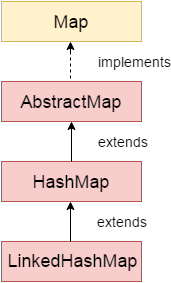Table of Contents
1. Đặc điểm
Những điểm quan trọng về lớp LinkedHashMap trong java cần nhớ là:
- LinkedHashMap lưu trữ dữ liệu dưới dạng cặp key và value.
- LinkedHashMap chỉ chứa các key duy nhất.
- LinkedHashMap có thể có 1 key là null và nhiều giá trị null.
- LinkedHashMap duy trì các phần tử theo thứ tự chèn.
2. Hierarchy của lớp LinkedHashMap

Lớp java.util.LinkedHashMap được định nghĩa như sau:
public class LinkedHashMap<K,V>
extends HashMap<K,V> implements Map<K,V> {
}
Trong đó:
- K: đây là kiểu key để lưu trữ.
- V: đây là kiểu giá trị được ánh xạ.
3. Các phương thức khởi tạo (constructor) của lớp LinkedHashMap
- LinkedHashMap(): khởi tạo một map trống.
- LinkedHashMap(Map<? extends K, ? extends V> m): khởi tạo một map với các phần tử của map m.
4. Các phương thức (method) của lớp LinkedHashMap
Xem thêm các phương thức của Map ở bài viết Map Interface trong java.
5. Ví dụ minh họa
5.1. Ví dụ sử dụng LinkedHashMap với kiểu dữ liệu cơ bản (Wrapper)
package com.maixuanviet.collection.linkedhashmap;
import java.util.LinkedHashMap;
import java.util.Map;
import java.util.Map.Entry;
public class LinkedHashMapExample {
public static void main(String args[]) {
// init map
Map<Integer, String> map = new LinkedHashMap<Integer, String>();
map.put(1, "Basic java");
map.put(2, "OOP");
map.put(4, "Multi-Thread");
map.put(3, "Collection");
// show map using method keySet()
for (Integer key : map.keySet()) {
String value = map.get(key);
System.out.println(key + " = " + value);
}
System.out.println("---");
// show map using method keySet()
for (Entry<Integer, String> entry : map.entrySet()) {
Integer key = entry.getKey();
String value = entry.getValue();
System.out.println(key + " = " + value);
}
}
}
Kết quả thực thi chương trình trên:
1 = Basic java 2 = OOP 4 = Multi-Thread 3 = Collection --- 1 = Basic java 2 = OOP 4 = Multi-Thread 3 = Collection
5.2. Ví dụ sử dụng LinkedHashMap với key có kiểu String, value có kiểu Student
package com.maixuanviet.collection.map;
public class Student {
private int id;
private String name;
public Student(int id, String name) {
this.id = id;
this.name = name;
}
@Override
public String toString() {
return "Student [id=" + id + ", name=" + name + "]";
}
public int getId() {
return id;
}
public String getName() {
return name;
}
}
package com.maixuanviet.collection.linkedhashmap;
import java.util.LinkedHashMap;
import java.util.Map;
import java.util.Map.Entry;
public class LinkedHashMapExample2 {
public static void main(String args[]) {
// Student's data
Student student1 = new Student(1, "Student 1");
Student student2 = new Student(2, "Student 2");
Student student3 = new Student(3, "Student 3");
Student student4 = new Student(4, "Student 4");
// init map
Map<Integer, Student> map = new LinkedHashMap<Integer, Student>();
map.put(student1.getId(), student1);
map.put(student2.getId(), student2);
map.put(student4.getId(), student4);
map.put(student3.getId(), student3);
// show map using method keySet()
for (Integer key : map.keySet()) {
Student value = map.get(key);
System.out.println(key + " = " + value);
}
System.out.println("---");
// show map using method keySet()
for (Entry<Integer, Student> entry : map.entrySet()) {
Integer key = entry.getKey();
Student value = entry.getValue();
System.out.println(key + " = " + value);
}
}
}
Kết quả thực thi chương trình trên:
1 = Student [id=1, name=Student 1] 2 = Student [id=2, name=Student 2] 4 = Student [id=4, name=Student 4] 3 = Student [id=3, name=Student 3] --- 1 = Student [id=1, name=Student 1] 2 = Student [id=2, name=Student 2] 4 = Student [id=4, name=Student 4] 3 = Student [id=3, name=Student 3]
Related posts:
Configuring a DataSource Programmatically in Spring Boot
Spring Boot Change Context Path
Validations for Enum Types
Java Program to Create the Prufer Code for a Tree
Các kiểu dữ liệu trong java
Java Program to Implement Pairing Heap
Java Program to Check Cycle in a Graph using Graph traversal
Returning Custom Status Codes from Spring Controllers
Adding Shutdown Hooks for JVM Applications
Toán tử trong java
Guide to DelayQueue
Java Program to implement Circular Buffer
Một số ký tự đặc biệt trong Java
Java Program to Find a Good Feedback Edge Set in a Graph
Hướng dẫn Java Design Pattern – Proxy
Guide to WeakHashMap in Java
Mệnh đề if-else trong java
How to Kill a Java Thread
Using JWT with Spring Security OAuth (legacy stack)
Phương thức tham chiếu trong Java 8 – Method References
A Guide to the Java ExecutorService
Receive email using POP3
Convert Hex to ASCII in Java
Java 8 Streams peek() API
Một số từ khóa trong Java
Java Program to Implement the Hill Cypher
Comparing Strings in Java
Converting Between an Array and a Set in Java
Guide to PriorityBlockingQueue in Java
Java Program to Use Above Below Primitive to Test Whether Two Lines Intersect
Java Program to Implement Traveling Salesman Problem using Nearest neighbour Algorithm
A Guide to Queries in Spring Data MongoDB

